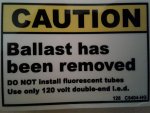Fly-Guy5
Member
- Location
- Saginaw County, MI
I will be retrofitting existing T8 fixtures to new LED tubes and pulled the following up during my research. Have any of you dealt with this issue?
"There is a deeper and more dangerous issue here that few people are aware of. My comments here specifically apply to tubes which are intended to be directly connected to a 120vac source (or branch circuit in UL terms). The tombstone or lampholder MUST BE RATED FOR DIRECT CONNECTION TO A BRANCH CIRCUIT. MOST ARE NOT!!! As of this writing, I don’t believe Leviton has a single holder that is rated to connect to a branch circuit directly. IT IS NOT SUFFICIENT TO SAY THAT BECAUSE A HOLDER IS NON-SHUNTED AND RATED AT SAY 600v AND 600w, it can be used. I have found only 1 manufacturer of holders(Stucchi 3000 series of Italy) that has tested and, in writing, certifies it can be used for DIRECT CONNECTION TO A BRANCH CIRCUIT(although I’m sure there are others since folks are selling retrofit ‘kits’ that contain the tube, holders, and a label) Look at the installation sheet of ANY Leviton tombstone, and the 2nd bullet in the upper left hand corner states it’s not intended for connection to a branch circuit. [The technical reason is that an arcing and sparking hazard exists when the tube fails in a way that produces a partial for full short circuit and high currents are drawn through the tombstone contact where it touches the pin. There are also issues with the physical installation of the tube and exposure of ‘live’ contacts to the installer or the luminaire]Keep this in mind if you choose to do a retrofit using direct connect tubes, or if you hire a contractor to do it for you! You don’t want an accident in your facility number one, and secondly don’t want to find out that your insurer won’t cover you because you did not have the proper tombstone!"
"There is a deeper and more dangerous issue here that few people are aware of. My comments here specifically apply to tubes which are intended to be directly connected to a 120vac source (or branch circuit in UL terms). The tombstone or lampholder MUST BE RATED FOR DIRECT CONNECTION TO A BRANCH CIRCUIT. MOST ARE NOT!!! As of this writing, I don’t believe Leviton has a single holder that is rated to connect to a branch circuit directly. IT IS NOT SUFFICIENT TO SAY THAT BECAUSE A HOLDER IS NON-SHUNTED AND RATED AT SAY 600v AND 600w, it can be used. I have found only 1 manufacturer of holders(Stucchi 3000 series of Italy) that has tested and, in writing, certifies it can be used for DIRECT CONNECTION TO A BRANCH CIRCUIT(although I’m sure there are others since folks are selling retrofit ‘kits’ that contain the tube, holders, and a label) Look at the installation sheet of ANY Leviton tombstone, and the 2nd bullet in the upper left hand corner states it’s not intended for connection to a branch circuit. [The technical reason is that an arcing and sparking hazard exists when the tube fails in a way that produces a partial for full short circuit and high currents are drawn through the tombstone contact where it touches the pin. There are also issues with the physical installation of the tube and exposure of ‘live’ contacts to the installer or the luminaire]Keep this in mind if you choose to do a retrofit using direct connect tubes, or if you hire a contractor to do it for you! You don’t want an accident in your facility number one, and secondly don’t want to find out that your insurer won’t cover you because you did not have the proper tombstone!"

